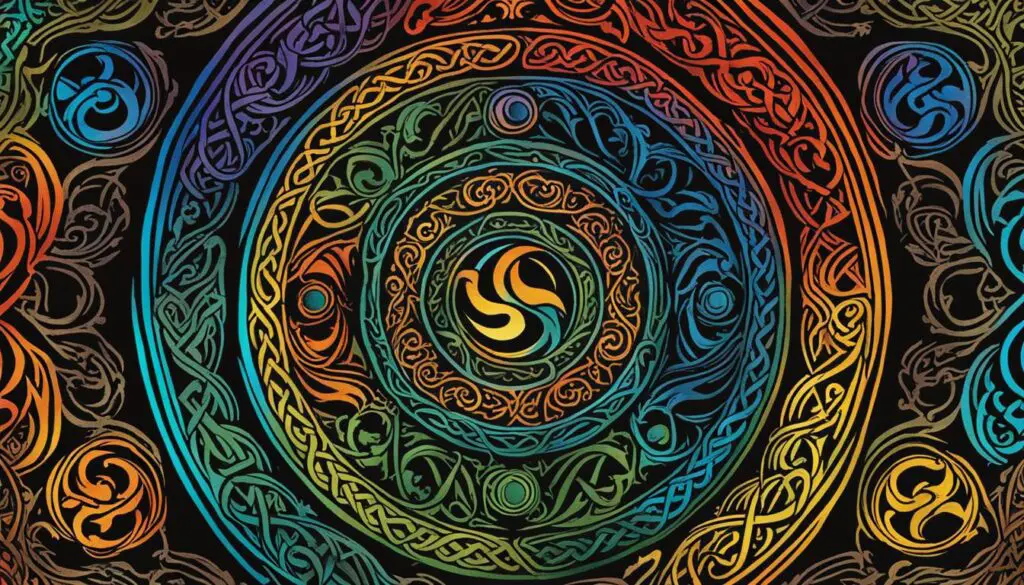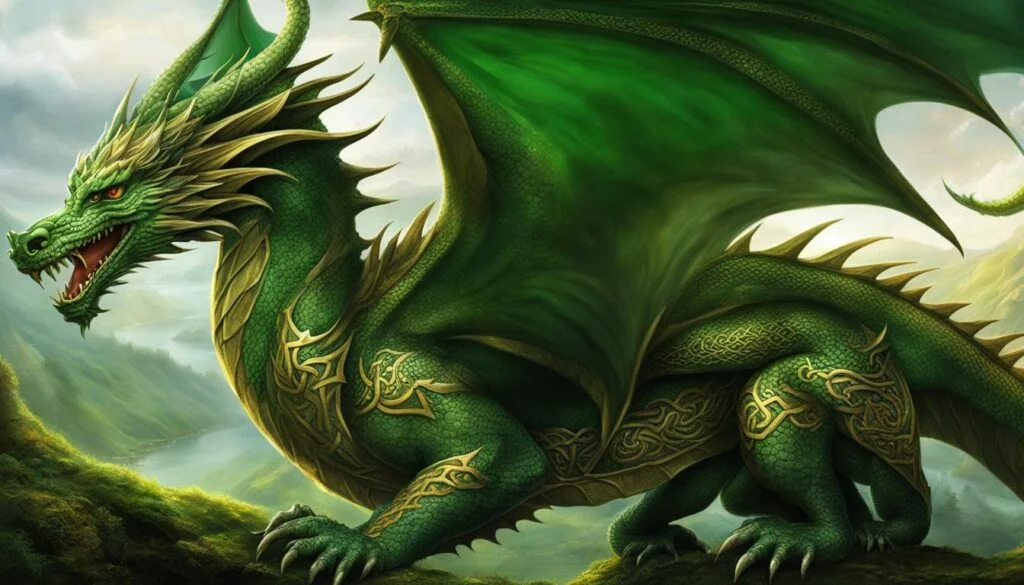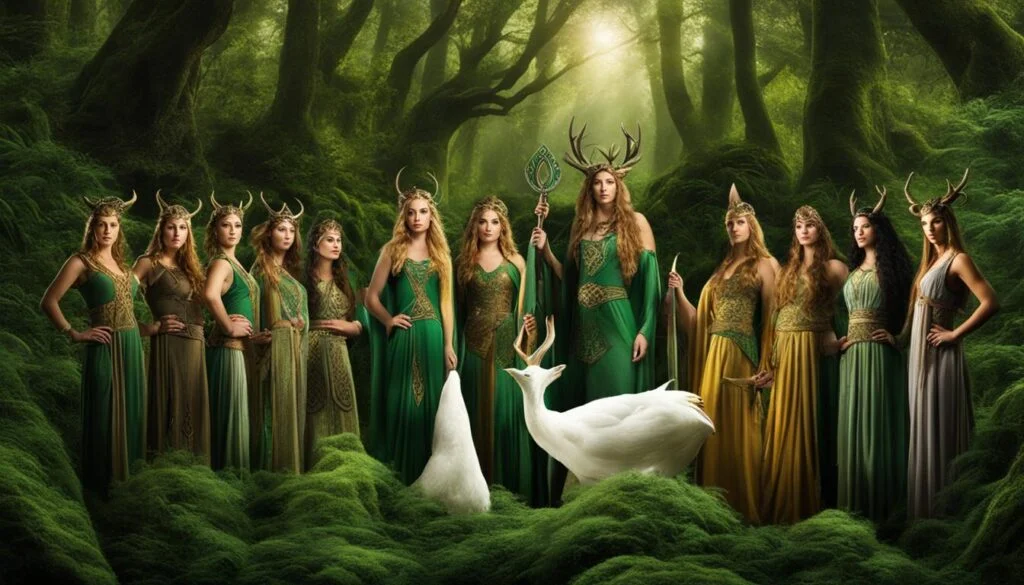Welcome to a journey through the captivating world of Celtic mythology! Irish mythology is a treasure trove of ancient stories and legends that have been passed down through generations. At the heart of this rich folklore are the four cycles of Celtic mythology. These cycles delve into the history, culture, and beliefs of the Celtic people, offering fascinating insights into their mystical past.
The four cycles of Celtic mythology are the Mythological Cycle, the Ulster Cycle, the Fenian Cycle, and the King Cycle. Each cycle has its own unique themes and narratives, weaving together tales of gods, heroes, and legendary battles. These cycles have greatly influenced Irish culture and continue to inspire modern interpretations in literature, film, and art.
From the mythological origins of Ireland to the heroic exploits of warriors, each cycle offers a captivating glimpse into different aspects of ancient Irish society. Join us as we dive into the timeless stories and characters that make up the fabric of Celtic mythology.
Key Takeaways:
- The four cycles of Celtic mythology are the Mythological Cycle, Ulster Cycle, Fenian Cycle, and King Cycle.
- Each cycle explores different aspects of ancient Irish history, culture, and society.
- Irish mythology continues to inspire modern interpretations in literature, film, and art.
- The stories and characters from Celtic mythology have had a profound impact on Irish culture and folklore.
- The gods and goddesses from Celtic mythology are still revered and celebrated today.
The Mythological Cycle
The Mythological Cycle is an enchanting part of Celtic mythology that delves into the origins of Ireland and its people. Through a collection of captivating stories, this cycle explores the rich tapestry of gods, supernatural events, and the settlement of early Celtic godlike beings in Ireland.
Central to the Mythological Cycle are the Tuatha Dé Danann, Fir Bolg, and Milesians, who play significant roles in shaping the mythological landscape. These captivating tales represent the divine beings who arrived in Ireland, bringing with them their ancient wisdom and power.
Written down by Irish monks between the 10th and 14th centuries, these stories have survived the test of time, preserving the essence of Celtic mythology. The Mythological Cycle shines a light on the mystical beginnings of Ireland, allowing us to delve into a world of mythical creatures, heroic feats, and the complex relationships between gods and mortals.
As we explore the vast array of Celtic mythology stories within the Mythological Cycle, we encounter a pantheon of gods and goddesses who embody different aspects of the human experience. These divine figures, such as the wise and powerful Dagda, the nurturing and creative Brigid, the skilled warrior Lugh, and the enigmatic Morrigan, continue to capture our imagination and inspire us to this day.
Join us on a journey through the mythological landscape of ancient Ireland as we unravel the tales of gods, supernatural events, and profound human connections woven within the Mythological Cycle of Celtic mythology.
The Ulster Cycle
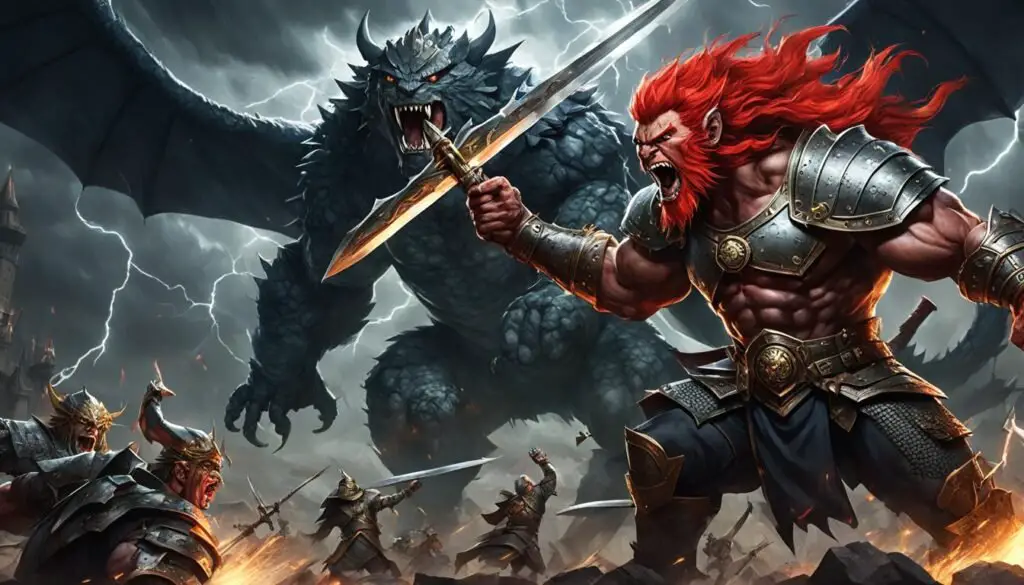
The Ulster Cycle, set in the first century, delves into the world of warriors and the sorrows of war in ancient Ulster. This cycle of Celtic folklore and mythology is a captivating exploration of conflict, honor, and bravery.
One of the key figures in the Ulster Cycle is King Conor Mac Nessa, a central character who faces numerous challenges and battles throughout the tales. The Red Branch Knights, a group of skilled warriors, also play a prominent role in the stories, showcasing their strength and valor.
However, the legendary hero Cú Chulainn steals the spotlight in many of the Ulster Cycle stories. Known for his exceptional skills and fierce determination, Cú Chulainn is a source of inspiration and fascination. His feats of bravery and his tragic fate make him a memorable figure in Celtic mythology.
The stories within the Ulster Cycle provide valuable insights into the conflicts, traditions, and heroes of ancient Ulster. They offer a unique window into the societal dynamics and cultural heritage of the time, reflecting the values and realities of a bygone era.
The Ulster Cycle, along with the other cycles of Celtic mythology, continues to captivate audiences with its rich storytelling and timeless themes. These stories have endured throughout the centuries, resonating with readers and inspiring future generations to delve into the world of Celtic folklore and mythology.
The Fenian Cycle
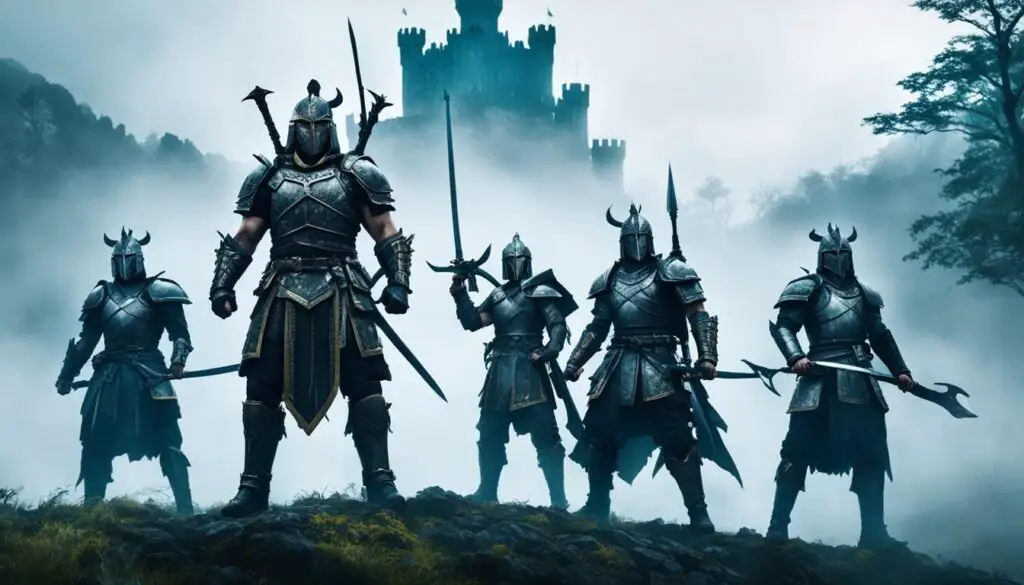
The Fenian Cycle is a fascinating part of Celtic mythology, dating back to the 3rd century AD. This cycle revolves around Munster, Leinster, and Scotland, and tells the stories of the legendary Fianna, a nomadic group of hunters and warriors.
In contrast to the war-like nature of other cycles, the Fenian Cycle portrays its protagonists with romantic attributes. It explores themes of love, heroism, and adventure, captivating audiences with its tales of bravery and enchantment.
At the heart of the Fenian Cycle is Finn MacCumhail, the main hero of this cycle. Finn gains incredible knowledge by consuming the mystical Fish of Knowledge, embarking on a mythological journey that shapes his destiny.
To truly appreciate the beauty and depth of the Fenian Cycle, one must immerse themselves in the legends, lore, and magic that permeate this captivating branch of Celtic mythology.
Key Features of the Fenian Cycle:
- Centered around Munster, Leinster, and Scotland
- Explores the adventures of the Fianna, a group of hunters and warriors
- Portrays protagonists with romantic attributes
- Focuses on the legendary hero Finn MacCumhail and his mythological journey
The King Cycle
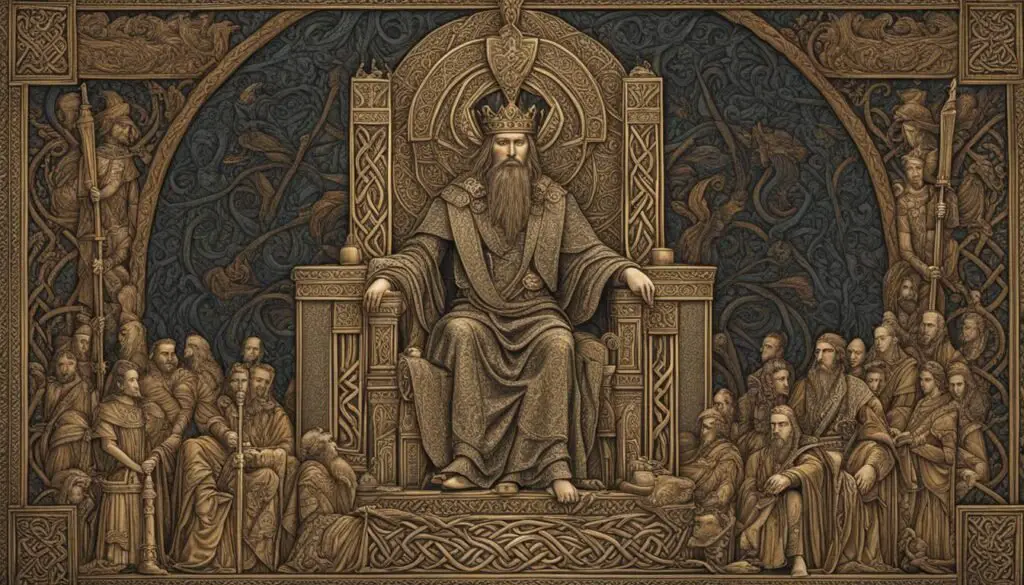
The King Cycle is a significant part of Celtic mythology, written between 200-475 AD. It weaves together historical figures, mythological settings, and moral adventures, offering valuable lessons on kingship and reflecting the transition from paganism to Christianity. These captivating stories focus on Irish kings, great houses, and the intricate interplay of history and fantasy.
Famous characters in the King Cycle include Labraid Loingsech, a legendary king associated with the Connachta dynasty, and the renowned historical figure Brian Boru, who played a crucial role in Irish history. Through these tales, readers unravel the qualities and responsibilities of a noble ruler, exploring the depths of celtic folklore and mythology.
In this cycle, readers are transported to a world where kings face numerous challenges, conflicts, and quests. These stories offer insights into the values, customs, and beliefs of ancient Celtic society. As readers follow the adventures of the protagonists, they witness the intricate balance between the earthly realm and the supernatural, and the profound impact of the mythological on the historical.
The King Cycle not only entertains but also illuminates the rich tapestry of celtic folklore and mythology. It serves as a testament to the enduring power of storytelling, allowing us to immerse ourselves in an ancient realm filled with bravery, myth, and magic.
The Influence and Legacy of Celtic Mythology
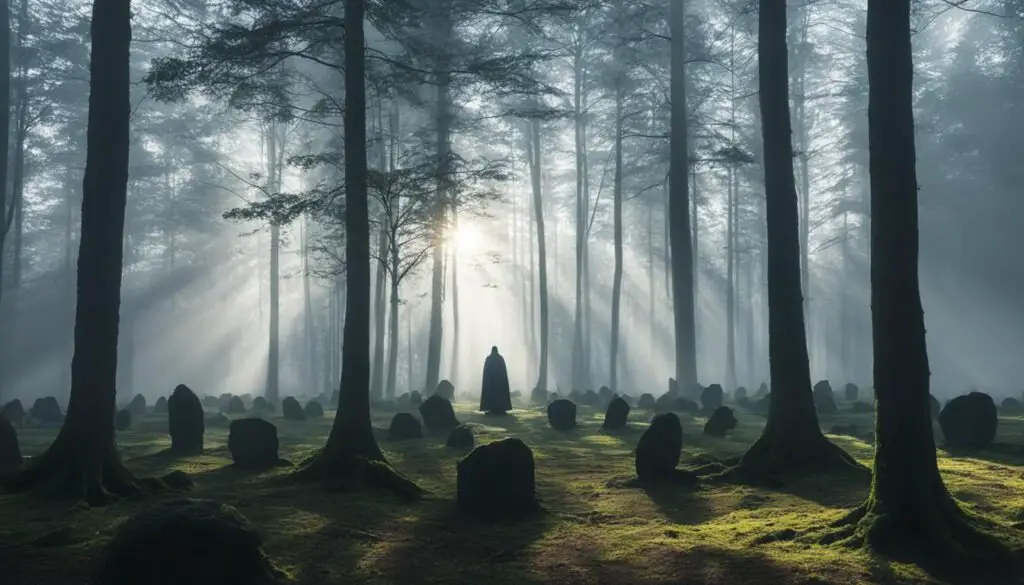
Celtic mythology, with its four cycles, has had a profound impact on Irish culture and folklore. The rich tapestry of stories and characters from these cycles continues to inspire modern interpretations in literature, film, and art.
The gods and goddesses of Celtic mythology, such as the Dagda, Brigid, Lugh, and the Morrigan, are still revered and celebrated in Ireland. These deities embody the essence of the ancient Celtic beliefs and serve as a link between the past and the present.
Many traditional Irish festivals and celebrations are rooted in the myths of the ancient Celts. The stories of the Tuatha Dé Danann, a race of godlike beings who arrived in Ireland in the Mythological Cycle, have become an integral part of Ireland’s cultural identity and are retold during festivals like Samhain and Bealtaine.
The influence of Celtic folklore and mythology extends beyond Ireland’s borders. Scholars and enthusiasts worldwide have been captivated by the enchanting tales and mystical characters that emerge from the realms of Celtic myth. These tales have been adapted into various forms of media, including novels, movies, and artwork, allowing the ancient Celtic traditions to reach a global audience.
The enduring legacy of Celtic mythology stands as a testament to the power of storytelling and the significance of cultural heritage. Through these mythical narratives, we gain insights into the values, beliefs, and complexities of the ancient Celtic civilization. As we continue to explore and appreciate these stories, we keep the spirit of Celtic myth alive, ensuring that future generations will be enchanted by the magic and wonder of the Celtic world.
Conclusion
The four cycles of Celtic mythology offer a captivating glimpse into the ancient history, culture, and beliefs of Ireland. These enduring tales have fascinated generations, weaving together elements of magic, heroism, and the complexities of the human experience.
In the Mythological Cycle, we discover the mythical origins of Ireland and the arrival of the Tuatha Dé Danann, Fir Bolg, and Milesians. These stories provide a foundation for understanding the land and its people, as well as the ancient gods and goddesses who shaped their destiny.
The Ulster Cycle transports us to an era of warriors and the tragedies of war. Through the riveting accounts of the Red Branch Knights, King Conor Mac Nessa, and the legendary hero Cú Chulainn, we witness tales of honor, sacrifice, and the relentless pursuit of glory.
The Fenian Cycle takes us on a journey through Munster, Leinster, and Scotland, where the celebrated Fianna pursue adventure, love, and wisdom. Led by the legendary Finn MacCumhail, these stories stand as testaments to the power of fate and the transformative nature of knowledge.
The King Cycle bridges history and myth, exploring the lives and morals of Irish kings. With heroes such as Labraid Loingsech and the renowned Brian Boru, these tales offer insights into the blending of pagan traditions with the rise of Christianity.
This vast tapestry of Celtic mythology continues to thrive in modern culture, inspiring writers, artists, and filmmakers. The gods and goddesses of old, including the mighty Dagda, the wise Brigid, the skilled Lugh, and the enigmatic Morrigan, remain revered figures in the hearts and minds of the Celtic people.
The mythology of the Celts is a testament to the power of storytelling, the enduring fascination with the past, and the timeless allure of ancient tales. As we delve into the intricate layers of celtic mythology and folklore, we embark on a journey into the very soul of a rich and vibrant tradition.
FAQ
What are the four cycles of Celtic mythology?
The four cycles of Celtic mythology are the Mythological Cycle, the Ulster Cycle, the Fenian Cycle, and the King Cycle.
What does the Mythological Cycle focus on?
The Mythological Cycle focuses on the origins of Ireland and its people, featuring stories of gods, supernatural events, and the settlement of early Celtic godlike beings in Ireland.
Who are the key figures in the Ulster Cycle?
The Ulster Cycle revolves around warriors and the sorrows of war, with key figures including the Red Branch Knights, King Conor Mac Nessa, and the legendary hero Cú Chulainn.
What is the Fenian Cycle centered around?
The Fenian Cycle is centered around Munster, Leinster, and Scotland, featuring the legendary Fianna, a nomadic group of hunters and warriors.
Who is the main hero of the Fenian Cycle?
The main hero of the Fenian Cycle is Finn MacCumhail, who attains knowledge by eating the Fish of Knowledge, sparking his mythological journey.
What is the King Cycle about?
The King Cycle combines historical figures, mythological settings, and moral adventures, providing examples of how to be a good king and reflecting the transition from paganism to Christianity.
Who are some famous characters in the King Cycle?
Some famous characters in the King Cycle include Labraid Loingsech and the real historical figure Brian Boru.
How has Celtic mythology influenced modern culture?
Celtic mythology has had a profound impact on Irish culture and folklore, inspiring modern interpretations in literature, film, and art. The gods and goddesses from Celtic mythology are still revered and celebrated, and many traditional Irish festivals are rooted in the myths of the Tuatha Dé Danann.
What can we learn from the four cycles of Celtic mythology?
The four cycles of Celtic mythology provide a captivating exploration of ancient Irish history, culture, and beliefs. They offer insights into the origins of Ireland, heroic tales of warriors, and moral lessons of kingship. These stories continue to enchant and inspire, reflecting the enduring power of storytelling and the vibrant mythology of the Celtic people.


